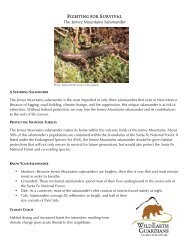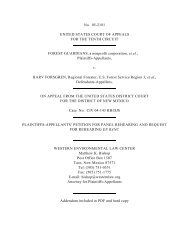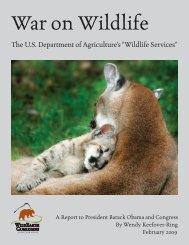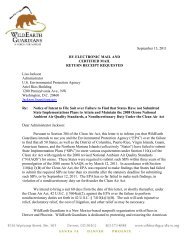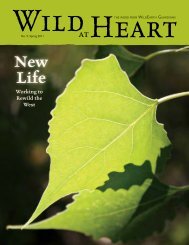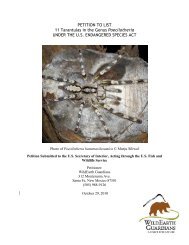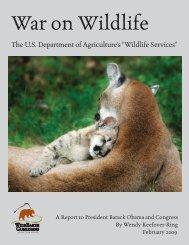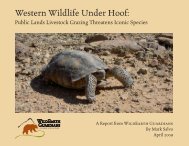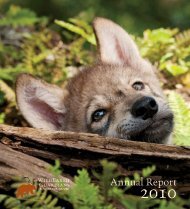Let the Listings Begin - WildEarth Guardians
Let the Listings Begin - WildEarth Guardians
Let the Listings Begin - WildEarth Guardians
You also want an ePaper? Increase the reach of your titles
YUMPU automatically turns print PDFs into web optimized ePapers that Google loves.
<strong>the</strong> word from <strong>WildEarth</strong> <strong>Guardians</strong><br />
No. 10, Summer 2011<br />
<strong>Let</strong> <strong>the</strong> <strong>Listings</strong> <strong>Begin</strong><br />
Historic Agreement<br />
Will Give Hundreds<br />
of Endangered Species<br />
a Chance at Protection
Mission Statement<br />
<strong>WildEarth</strong> <strong>Guardians</strong> protects and restores<br />
<strong>the</strong> wildlife, wild places, and wild rivers<br />
of <strong>the</strong> American West.<br />
Board of Directors<br />
Peter Schoenburg, President<br />
Robin Smith, Vice President<br />
Shannon Larsen, Treasurer<br />
Todd Ringler, Secretary<br />
Jess Alford<br />
Mike Brown<br />
Doug Erwin<br />
Stephanie Forrest<br />
Staff<br />
Whitney Bacon, IT Guru<br />
Bryan Bird, MS, Wild Places Program Director<br />
Rosie Brandenberger, Publications Manager<br />
Lori Colt, Communications Director<br />
Angelisa Espinoza, Office Administrator<br />
Kevin Gai<strong>the</strong>r-Banchoff, Development Director<br />
John Horning, Executive Director<br />
Taylor Jones, Endangered Species Advocate<br />
Mona Kay, Bookkeeper<br />
Wendy Keefover, MA, Carnivore Protection<br />
Director<br />
Jim Matison, Restoration Projects Director<br />
Jeremy Nichols, Climate & Energy Program<br />
Director<br />
Carol Norton, Associate Director<br />
Nicole Rosmarino, PhD, Wildlife Program<br />
Director<br />
Samantha Ruscavage-Barz, Staff Attorney<br />
Mark Salvo, JD, Sagebrush Sea Campaign<br />
Director<br />
Jay Tutchton, General Counsel<br />
Ashley Wilmes, Staff Attorney<br />
<strong>WildEarth</strong> <strong>Guardians</strong> is a 501(c)(3)<br />
tax-exempt organization.<br />
Santa Fe Office:<br />
312 Montezuma Ave.<br />
Santa Fe, NM 87501<br />
Tel 505.988.9126<br />
Fax 505.989.8623<br />
Denver Office:<br />
1536 Wynkoop St.<br />
Ste. 301<br />
Denver, CO 80202<br />
Tel 303.573.4898<br />
Offices also in:<br />
Phoenix, Tucson, Boulder<br />
2<br />
Mark Rickman<br />
Vanessa Scurci<br />
Jon Spar<br />
Bill Syme<br />
Special thanks to Jean Martin for copy editing.<br />
Cover: <strong>WildEarth</strong> <strong>Guardians</strong>’ settlement agreement<br />
with <strong>the</strong> US Fish & Wildlife Service requires <strong>the</strong><br />
agency to ei<strong>the</strong>r propose to list or issue a “not<br />
warranted” finding for <strong>the</strong> Coral Pink Sand Dunes<br />
tiger beetle by October 2012. PHOTO: Chris Wirth.<br />
100 percent recycled, 50 percent PCW<br />
Restoring <strong>the</strong> Vision<br />
obody likes to wait — especially in <strong>the</strong> emergency room at <strong>the</strong> hospital,<br />
N when every minute counts. But that’s exactly what’s happened for<br />
hundreds of America’s most endangered, but as yet unprotected, plants and<br />
animals. More than 250 species are currently waiting for what <strong>the</strong>y need most:<br />
formal protection under <strong>the</strong> Endangered Species Act (ESA).<br />
Most of <strong>the</strong>se candidates have been waiting for more than 20 years for<br />
listing. And now, thanks to a historic legal settlement between <strong>WildEarth</strong><br />
<strong>Guardians</strong> and <strong>the</strong> U.S. Fish and Wildlife Service (FWS), <strong>the</strong> wait is over — or<br />
at least soon to be over, now that <strong>the</strong>re is finally a legally enforceable agreement<br />
that will require <strong>the</strong> FWS to make decisions that could move 253 of <strong>the</strong>se<br />
imperiled species onto <strong>the</strong> protective ark that is <strong>the</strong> ESA. Ano<strong>the</strong>r 600-plus<br />
species will also receive some attention moving <strong>the</strong>m through <strong>the</strong> ESA listing<br />
process. It’s going to take a little while because <strong>the</strong> waiting line grew and grew<br />
longer under past administrations that ignored <strong>the</strong> problem.<br />
For species such as <strong>the</strong> greater sage-grouse, lesser prairie-chicken, lynx,<br />
and Sonoran desert tortoise, <strong>the</strong> end to <strong>the</strong> waiting is long overdue. Oil and gas<br />
drilling, sprawling human population growth and climate change continue to<br />
fragment and degrade <strong>the</strong> wild habitats <strong>the</strong>se animals need to survive.<br />
This historic agreement is in place thanks to <strong>the</strong> legal tactics, energy,<br />
brilliance, and negotiating skills of two <strong>WildEarth</strong> <strong>Guardians</strong> staff members:<br />
Jay Tutchton and Nicole Rosmarino. This duo has been working for more than<br />
a decade to secure protection for endangered species and this legal settlement<br />
is a cornerstone of an edifice of accomplishments in <strong>the</strong> fight to protect<br />
imperiled biodiversity.<br />
There will be much more work to be done for certain, but for this<br />
moment I am extremely proud of what <strong>WildEarth</strong> <strong>Guardians</strong> has<br />
accomplished.<br />
Visit our website: Top Priorities>Endangered Species Act Listing>Candidate<br />
Settlement Milestone<br />
guardians giver<br />
Con Slobodchikoff<br />
John Horning<br />
Con Slobodchikoff is a prairie dog’s best friend and a<br />
true Guardian. The Professor Emeritus of Biology<br />
at Nor<strong>the</strong>rn Arizona University says, “Prairie dogs are<br />
an iconic image of <strong>the</strong> Old West. Lewis and Clark sent a<br />
prairie dog to Thomas Jefferson when our country was<br />
young. In times past, <strong>the</strong>y seemed to be everywhere.<br />
Now <strong>the</strong>ir numbers are greatly reduced due to humanintroduced<br />
disease, poisoning, shooting, and development.<br />
They are heading <strong>the</strong> same way as <strong>the</strong> passenger<br />
pigeon; everyone said <strong>the</strong>re were plenty of pigeons until<br />
<strong>the</strong> last one died.<br />
Prairie dogs are a keystone species in plains grassland ecosystems, holding<br />
toge<strong>the</strong>r <strong>the</strong> energetic food web and performing many ecosystem functions.<br />
<strong>WildEarth</strong> <strong>Guardians</strong> is taking action to save prairie dogs so <strong>the</strong>y don’t go<br />
extinct, which would undermine <strong>the</strong> biodiversity of <strong>the</strong> plains grasslands. The<br />
<strong>Guardians</strong> have been doing an excellent job of trying to save species such as<br />
prairie dogs so that our children and <strong>the</strong>ir children will be able to see some of <strong>the</strong><br />
same animals and plants that <strong>the</strong> settlers of <strong>the</strong> Old West routinely saw.”
adriel heisey<br />
The Rio Grande: An Eagle’s View<br />
<strong>WildEarth</strong> <strong>Guardians</strong> recently<br />
released a large format book featuring aerial<br />
photographs by well-known photographer<br />
Adriel Heisey. The book’s goal is to reconnect<br />
people to <strong>the</strong> great river and inspire <strong>the</strong>m<br />
with its beauty and fragility.<br />
John Horning<br />
From controversy emerged a desire for <strong>the</strong><br />
transcendent power of beauty.<br />
In late April 1996, after a winter drought whose grip<br />
extended deep into spring, a spark ignited a blaze along<br />
<strong>the</strong> Rio Grande — but <strong>the</strong> flames that swept up and down<br />
<strong>the</strong> watershed that spring were flames not of fire, but of<br />
controversy about <strong>the</strong> fate of <strong>the</strong> river itself. That spring<br />
more than 60 miles of <strong>the</strong> river went completely dry as<br />
irrigators diverted <strong>the</strong> entire flow of <strong>the</strong> river. As a result<br />
more than 10,000 endangered Rio Grande silvery<br />
minnows perished.<br />
With <strong>the</strong> bones of <strong>the</strong> river exposed that spring,<br />
<strong>WildEarth</strong> <strong>Guardians</strong> emerged as a fierce voice for a<br />
new river ethic, one in which <strong>the</strong> river had rights to its<br />
own waters.<br />
As <strong>the</strong> conflict over <strong>the</strong> river’s water intensified, both<br />
in court and in public forums up and down <strong>the</strong> river,<br />
<strong>Guardians</strong> realized we needed more than just winning<br />
legal strategies and compelling alternatives to <strong>the</strong> flawed<br />
water management paradigm of <strong>the</strong> time. We also needed<br />
to reconnect people to <strong>the</strong> Rio Grande and inspire <strong>the</strong>m<br />
with its beauty and fragility.<br />
The Rio Grande: An Eagle’s View, <strong>WildEarth</strong><br />
<strong>Guardians</strong>’ recently released large format book of aerial<br />
photographs of <strong>the</strong> Rio Grande, seeks to do just that.<br />
Begun in 2000 — in <strong>the</strong> midst of <strong>the</strong> controversy over <strong>the</strong><br />
river’s future — <strong>the</strong> book features <strong>the</strong> work of well-known aerial photographer Adriel Heisey.<br />
Heisey chronicles <strong>the</strong> river from its headwaters along <strong>the</strong> spine of <strong>the</strong> Rocky Mountains in<br />
Colorado to its delta in <strong>the</strong> Gulf of Mexico in Texas. The book includes nearly 200 color<br />
photographs of <strong>the</strong> river’s wild canyons, lush wetlands, and riverside forests. All told, Heisey<br />
took more than 26,000 photographs of <strong>the</strong> river as part of this project.<br />
Complementing Heisey’s exquisite images are brief essays by noted actor and conservationist<br />
Robert Redford, Senator Tom Udall and <strong>Guardians</strong> Executive Director John Horning.<br />
Anchoring <strong>the</strong> written narrative is a longer essay by Steve McDowell about <strong>the</strong> history and<br />
evolution of a conservation ethic along <strong>the</strong> Rio Grande.<br />
With <strong>the</strong> long journey to produce <strong>the</strong> book now<br />
complete, our next goal is to get <strong>the</strong> book into as<br />
many hands as possible. All proceeds from book sales<br />
will directly support our campaign to protect and<br />
restore <strong>the</strong> Rio Grande. The book is available directly<br />
from our website, wildearthguardians.org.<br />
THE RIO GRANDE<br />
AN EAGLE’S VIEW<br />
SAve <strong>the</strong> Dates<br />
for <strong>the</strong>se<br />
<strong>WildEarth</strong> Events<br />
September 17<br />
Rio Grande book<br />
event at Bookworks,<br />
Albuquerque<br />
September 21<br />
Rio Grande book event<br />
at Collected Works,<br />
Santa Fe<br />
September 30<br />
<strong>Guardians</strong> Gala,<br />
Santa Fe<br />
October 12<br />
Rio Grande book event<br />
at Tattered Cover,<br />
Denver<br />
November 4<br />
Tree Hugger Bash,<br />
Albuquerque<br />
November 17<br />
Festival of <strong>the</strong><br />
Cranes book event,<br />
Socorro, NM<br />
Keep an eye out for<br />
invitations to book<br />
events and o<strong>the</strong>r<br />
ga<strong>the</strong>rings in Arizona,<br />
Colorado and Texas.<br />
Photographs by Adriel Heisey<br />
Edited by Barbara McIntyre<br />
Foreword by Robert Redford<br />
The Rio Grande:<br />
An Eagle’s View<br />
Photographs by Adriel Heisey<br />
Essays by Robert Redford, Senator Tom Udall,<br />
Steve McDowell and John Horning<br />
Published by <strong>WildEarth</strong> <strong>Guardians</strong>, 2011<br />
Hardcover, 240 pages, $75<br />
www.<strong>the</strong>riograndeaneaglesview.com<br />
3
Why Are YOU<br />
a Guardian?<br />
“Growing up I saw<br />
<strong>the</strong> wild places I<br />
roamed bulldozed for<br />
housing developments.<br />
Eventually I saw <strong>the</strong><br />
wildlife species in<br />
my neighborhood<br />
disappear. I see <strong>the</strong><br />
same thing happening<br />
today and am<br />
especially saddened<br />
by <strong>the</strong> toll it’s taking<br />
on prairie dogs. I<br />
strive to educate my<br />
friends about how<br />
important prairie dogs<br />
are to <strong>the</strong>ir ecosystem.<br />
People enjoy seeing<br />
foxes or hawks in <strong>the</strong>ir<br />
neighborhood, but<br />
<strong>the</strong>y often don’t realize<br />
that those species rely<br />
on prey like prairie<br />
dogs to survive.”<br />
4<br />
— Trinity Demask<br />
Arvada, Colorado,<br />
resident and singersongwriter<br />
speaking<br />
out for wildlife<br />
Become a member of<br />
<strong>WildEarth</strong> <strong>Guardians</strong>:<br />
wildearthguardians.org<br />
Mega-Fires in <strong>the</strong> Southwest<br />
The Perfect Storm<br />
Arizona and New Mexico have<br />
each reently set records for<br />
<strong>the</strong> largest single fire in each state’s<br />
documented history. With <strong>the</strong><br />
smoke still lingering, <strong>the</strong> public is<br />
asking: Why? The answer: Decades of<br />
resource mismanagement and severe<br />
drought resulting from climate change<br />
have created <strong>the</strong> perfect storm for<br />
mega-fires. In fact, <strong>the</strong>se mega-fires<br />
have become predictable.<br />
We must go back several decades<br />
to understand how <strong>the</strong> current<br />
wildfire situation arose. During <strong>the</strong><br />
last hundred years or so <strong>the</strong> lower<br />
elevation, dry forests in <strong>the</strong> West<br />
were severely logged, leaving a nearly uniform<br />
mass of small trees. Domestic livestock grazing,<br />
which suppresses <strong>the</strong> grasses that typically carry<br />
forest-cleansing, low intensity fire, fostered <strong>the</strong><br />
proliferation of pine seedlings and aggravated<br />
conditions. On top of it all, humans developed<br />
a highly effective, military-style response to<br />
wildfire, leaving <strong>the</strong> overgrowth unchecked.<br />
Some have suggested logging <strong>the</strong>se forests<br />
to save <strong>the</strong>m. The proposition is both unwise<br />
and untenable. Cutting itself out of business, <strong>the</strong><br />
lumber industry has mostly disappeared in <strong>the</strong><br />
West and <strong>the</strong> market for lumber is at record lows,<br />
in sync with <strong>the</strong> depressed housing market; even<br />
if we threw aside all environmental concerns<br />
and opened our public forestlands to logging on<br />
an historic scale, <strong>the</strong>re would still be no use for<br />
<strong>the</strong> logs. In a free market system <strong>the</strong>re has to be<br />
demand or no amount of deregulation is going to<br />
make a difference — and logging will not change<br />
<strong>the</strong> wea<strong>the</strong>r.<br />
Now climate change and drought<br />
are increasing <strong>the</strong> flammability of <strong>the</strong>se<br />
forests, already vulnerable from decades of<br />
mismanagement, resulting in <strong>the</strong> Wallow (841<br />
square miles) and Las Conchas (214 square<br />
miles) fires. The science is clear: Big fire years<br />
track drought cycles, and climate change is<br />
exacerbating those conditions. The ongoing<br />
fires are predictable, but can we do anything to<br />
mitigate <strong>the</strong>ir impacts and manage <strong>the</strong> risk to<br />
humans? Yes, we can.<br />
Innovative, collaborative efforts are quietly<br />
reshaping <strong>the</strong> federal forest policies that got us<br />
here in <strong>the</strong> first place and charting a sustainable<br />
future for <strong>the</strong> National Forest System. Starting in<br />
2001 with Senator Jeff Bingaman’s Collaborative<br />
Forest Restoration Program (CFRP) in New<br />
Mexico, now expanded nationally, former<br />
Bryan Bird<br />
Decades of resource mismanagement and severe drought resulting<br />
from climate change have created conditions for this summer’s<br />
mega-fires throughout <strong>the</strong> West.<br />
adversaries began developing forest restoration<br />
projects that are environmentally sound and<br />
effective in restoring forest health. In New<br />
Mexico alone, more than 30,000 acres have<br />
been addressed and approximately 600 jobs<br />
created through CFRP.<br />
On federal, public forests, where small<br />
trees and brush are <strong>the</strong> problem, cost-effective<br />
fuel reduction is accomplished with o<strong>the</strong>r tools<br />
including wildland fire use, prescribed fire,<br />
thinning, and reduced livestock grazing. Last<br />
year <strong>the</strong> Forest Service reduced hazardous fuels<br />
on 1.5 million acres using methods such as<br />
forest thinning and prescribed burns; many of<br />
<strong>the</strong> fuel-reduction areas are strategically located<br />
around communities and proved critical in<br />
defending Arizona towns in <strong>the</strong> latest blaze.<br />
Ano<strong>the</strong>r cost-effective action that can be<br />
taken immediately by <strong>the</strong> federal land managers<br />
is closing grazing allotments so that healthy<br />
grass communities can recover. <strong>WildEarth</strong><br />
<strong>Guardians</strong> is advocating for voluntary grazing<br />
permit retirement in ponderosa pine and<br />
dry mixed conifer forests, which would have<br />
instantaneous positive effects for restoring<br />
natural fire regimes. We live in a time of<br />
shrinking federal budgets and acute effects from<br />
climate change. Strategic use of resources will<br />
be critical. In addition to eliminating livestock<br />
grazing pressure and forest fuel treatments,<br />
it is time for responsible citizens to demand<br />
appropriate county zoning and insist on placing<br />
<strong>the</strong> enormous costs of firefighting on <strong>the</strong> parties<br />
that encourage development in fire-prone<br />
forests. That is <strong>the</strong> essential work to avert megafires<br />
in a climate-changed world.<br />
Visit our website:<br />
Programs>Wildlands>Public Lands Advocacy<br />
John McColgan, USDA
Climate Watch<br />
Clean Air and a Safe Climate in <strong>the</strong> West<br />
ur efforts to power past coal took a big<br />
O step forward in June as <strong>WildEarth</strong><br />
<strong>Guardians</strong> reached a milestone settlement<br />
agreement to curb thousands of tons of toxic<br />
air pollution in Colorado, Montana, North<br />
Dakota, and Wyoming.<br />
The agreement puts at least 18 coalfired<br />
power plants totaling more than 16,000<br />
megawatts on <strong>the</strong> path to cleaner operations<br />
and opening <strong>the</strong> door to retire or transition<br />
<strong>the</strong>m to cleaner, greener energy.<br />
That’s good news for <strong>the</strong> West’s most<br />
cherished wildlands, for public health, and for<br />
our climate.<br />
The agreement resolves a lawsuit we<br />
filed last January in response to <strong>the</strong> U.S.<br />
Environmental Protection Agency’s (EPA)<br />
delay in tackling haze pollution throughout<br />
<strong>the</strong> country. The Clean Air Act (CAA)<br />
requires that <strong>the</strong> EPA ensure states have plans<br />
in place to reduce haze in what are known<br />
as “Class I” areas. These Class I areas include<br />
most National Parks and Wilderness Areas,<br />
pristine landscapes that are also bellwe<strong>the</strong>rs<br />
for <strong>the</strong> health of our air.<br />
The keystone of <strong>the</strong>se plans is a CAA<br />
requirement that states clean up <strong>the</strong>ir oldest<br />
and dirtiest coal-fired power plants, <strong>the</strong><br />
largest sources of haze pollution in <strong>the</strong> West.<br />
Unfortunately, states have been slow to adopt<br />
haze reduction plans. In 2009, <strong>the</strong> EPA found<br />
that virtually every state had failed to submit<br />
<strong>the</strong> plans as required by <strong>the</strong> CAA.<br />
Our settlement guarantees that haze<br />
reduction plans will be finally adopted for<br />
Colorado, Montana, North Dakota, and<br />
Wyoming. Under <strong>the</strong> agreement, <strong>the</strong> EPA<br />
will propose and finalize <strong>the</strong> plans according<br />
to <strong>the</strong> schedule below. We’ll start seeing<br />
progress as early as July 2011 with a proposed<br />
plan for North Dakota; that plan will be<br />
finalized by January 2012.<br />
State Proposal Final approval<br />
of plan<br />
of plan<br />
Colorado Mar. 8, 2012 Sept. 6, 2012<br />
Montana Jan. 20, 2012 June 29, 2012<br />
N. Dakota July 21, 2011 Jan. 26, 2012<br />
Wyoming Apr. 15, 2012 Oct. 15, 2012<br />
These plans promise widespread<br />
reductions in air pollution, but <strong>the</strong> most<br />
significant benefits will occur as coal-fired<br />
power plants are targeted for clean-up.<br />
Our agreement paves <strong>the</strong> way to clean<br />
up, repower, or outright retire at least 18<br />
Jeremy Nichols<br />
<strong>WildEarth</strong> <strong>Guardians</strong> reached a milestone settlement<br />
agreement in June that will require states to clean up <strong>the</strong><br />
oldest and dirtiest coal-fired power plants across <strong>the</strong> West.<br />
coal-fired power plants, which toge<strong>the</strong>r annually<br />
release more than 200,000 tons of sulfur<br />
dioxide, 150,000 tons of nitrogen oxide, and 120<br />
million tons of carbon dioxide into <strong>the</strong> air we<br />
brea<strong>the</strong>. Colorado, for example, has proposed<br />
to retire or repower five coal-fired power plants<br />
in <strong>the</strong> state as part of <strong>the</strong>ir haze plan. Our<br />
settlement ensures this plan becomes a reality.<br />
We’ve still got work to do to power past<br />
coal, but this agreement is significant progress.<br />
Visit our website: Top Priorities>Power Past Coal<br />
Cleaning up coal-fired power plants will reduce thousands<br />
of tons of toxic air pollution and result in cleaner skies for<br />
wildlands, public health and <strong>the</strong> climate.<br />
dennis kost<br />
Why Are YOU<br />
a Guardian?<br />
“Life on Earth is on<br />
<strong>the</strong> run, and only<br />
dedicated individuals<br />
working toge<strong>the</strong>r<br />
through <strong>the</strong> efforts of<br />
amazing groups like<br />
<strong>WildEarth</strong> <strong>Guardians</strong><br />
can match humanity’s<br />
destructive power<br />
and greed with our<br />
power for compassion<br />
and responsibility.<br />
Only passion and<br />
unrelenting advocacy<br />
on behalf of <strong>the</strong>se<br />
beautiful creatures<br />
can prevent ano<strong>the</strong>r<br />
catastrophe. I refuse<br />
to let that happen,<br />
and will never stop<br />
doing anything and<br />
everything that I can<br />
to prevent it.”<br />
— Ian Field<br />
San Diego, California,<br />
resident and member<br />
speaking out for <strong>the</strong><br />
lobo<br />
Become a member of<br />
<strong>WildEarth</strong> <strong>Guardians</strong>:<br />
wildearthguardians.org<br />
5
Why Are YOU<br />
a Guardian?<br />
In <strong>the</strong> Halls of Justice<br />
Samantha Ruscavage-Barz, Jay Tutchton, and Ashley Wilmes<br />
<strong>WildEarth</strong> <strong>Guardians</strong>’ legal team has been hard at work to make sure <strong>the</strong> cries of <strong>the</strong> West’s<br />
wildlands and wildlife are heard in courtrooms before it’s too late. The following cases are a<br />
few highlights.<br />
“I like what <strong>WildEarth</strong><br />
<strong>Guardians</strong> is doing<br />
because I like helping<br />
animals and I’m hoping<br />
that no animals will<br />
ever go extinct again.”<br />
To show her support<br />
of our “End <strong>the</strong> War<br />
on Wildlife” campaign,<br />
Emma recently made<br />
this sign for a school<br />
report. Emma shows<br />
that activism starts and<br />
can have an impact at<br />
any age.<br />
— Emma Lieberman with<br />
6<br />
her grandmo<strong>the</strong>r Rose<br />
Telpner<br />
Daughter and mo<strong>the</strong>r<br />
of recent <strong>WildEarth</strong><br />
<strong>Guardians</strong> house<br />
party hostess Martha<br />
Lieberman, Phoenix,<br />
Arizona<br />
Become a member of<br />
<strong>WildEarth</strong> <strong>Guardians</strong>:<br />
wildearthguardians.org<br />
tim springer<br />
bryan bird<br />
Anti-Wolf Rider:<br />
Nor<strong>the</strong>rn Rockies<br />
Wolf Delisted<br />
<strong>WildEarth</strong><br />
<strong>Guardians</strong> joined<br />
with Alliance for <strong>the</strong><br />
Wild Rockies and<br />
Friends of <strong>the</strong><br />
Clearwater to file a lawsuit challenging <strong>the</strong><br />
constitutionality of <strong>the</strong> Congressional budget<br />
rider that removed Endangered Species Act<br />
protection for wolves throughout much of <strong>the</strong><br />
Nor<strong>the</strong>rn Rockies (except Wyoming). The suit,<br />
filed on May 5, 2011, has been set for expedited<br />
briefing by <strong>the</strong> federal judge who oversees <strong>the</strong><br />
case. We believe <strong>the</strong> fate of wolves should not be<br />
ruled by backroom political deals that destroy <strong>the</strong><br />
checks and balances fundamental to our<br />
democracy. The case is important for endangered<br />
species, as <strong>the</strong> budget rider delisting <strong>the</strong> Nor<strong>the</strong>rn<br />
Rockies wolves marked <strong>the</strong> first time a species<br />
has been legislatively delisted. The case also has<br />
far-reaching consequences for our law-making<br />
process: Important policy decisions should not be<br />
footnotes to must-pass budget deals.<br />
Curbing Uranium Development<br />
in New Mexico<br />
<strong>WildEarth</strong> <strong>Guardians</strong> and o<strong>the</strong>r groups<br />
filed suit in federal court on April 28, 2011,<br />
challenging <strong>the</strong> U.S. Forest Service’s (USFS)<br />
rules that preclude citizen objections to uranium<br />
exploration permits. The Appeals Reform<br />
Act requires that all “proposed actions of <strong>the</strong><br />
U.S. Forest Service concerning projects and<br />
activities implementing land and resource<br />
management plans” must be subject to public<br />
notice, comment, and administrative appeal, yet<br />
<strong>the</strong> challenged regulations illegally exempt all<br />
actions that are “categorically excluded” from <strong>the</strong><br />
need to prepare an Environmental Assessment<br />
or Environmental Impact Statement under<br />
National Environmental Policy Act (NEPA)<br />
regulations for public notice, comment<br />
and appeal. On September 17, 2010, <strong>the</strong><br />
USFS approved <strong>the</strong> White Mesa Uranium<br />
Exploration project in <strong>the</strong> Cibola National<br />
Forest, which would allow exploratory<br />
drilling for uranium mining, employing a<br />
categorical exclusion under its NEPA rules<br />
and exempting it from administrative appeal<br />
under <strong>the</strong> regulations. <strong>WildEarth</strong> <strong>Guardians</strong><br />
commented on <strong>the</strong> proposal and would have<br />
appealed this project, but were denied <strong>the</strong> right<br />
under <strong>the</strong> challenged USFS rules.<br />
Mexican<br />
Wolf<br />
Recovery<br />
Program<br />
Update<br />
In 2008,<br />
<strong>WildEarth</strong><br />
<strong>Guardians</strong> and<br />
The Rewilding<br />
Institute filed<br />
suit against <strong>the</strong> U.S. Fish & Wildlife Service<br />
(FWS) and <strong>the</strong> U.S. Forest Service (USFS)<br />
regarding <strong>the</strong> federal government’s failed<br />
stewardship of <strong>the</strong> Mexican Wolf Recovery<br />
Program. The lawsuit challenged FWS’s<br />
controversial management protocol dubbed<br />
SOP 13. The policy mandated <strong>the</strong> permanent<br />
removal of wolves known or thought to<br />
have been involved in three conflicts with<br />
livestock in any 365-day period. The lawsuit<br />
also targeted <strong>the</strong> USFS’s failure to carry out<br />
a conservation program for <strong>the</strong> Mexican<br />
gray wolf within its own recovery zone in a<br />
heavily grazed area made up almost entirely<br />
of National Forest lands. <strong>Guardians</strong> enjoyed<br />
mixed success in this case. In a victory for<br />
wolves and for <strong>Guardians</strong>, FWS withdrew<br />
SOP 13 and promised not to use it in <strong>the</strong><br />
future. The Court also ruled that USFS does<br />
not have to prepare its own Mexican Wolf<br />
Recovery Plan, but must help <strong>the</strong> FWS<br />
implement <strong>the</strong> existing recovery plan to benefit<br />
<strong>the</strong> wolf. Our next step is getting FWS to<br />
develop an effective and “real” recovery plan,<br />
which USFS must help implement under <strong>the</strong><br />
Court’s holding in our case.<br />
Visit our website: Take Action>Current Actions<br />
mexican wolf<br />
interagency field office
lynne stone<br />
jeremy nichols<br />
campaign updates<br />
Effort to Cut Federal Carnivore Killing<br />
Program Budget Fails<br />
In June 2011, U.S. Representatives John Campbell and<br />
Peter DeFazio introduced an amendment to cut a privateinterest<br />
subsidy to agriculture by $11 million. It would have<br />
defunded <strong>the</strong> federal government’s program for slaughtering<br />
115,000 coyotes, cougars, and o<strong>the</strong>r native carnivores each<br />
year purportedly to protect domestic livestock. Dozens of<br />
agricultural industry groups and shooting organizations such<br />
as <strong>the</strong> National Rifle Association and Safari Club opposed <strong>the</strong><br />
amendment, using false scare tactics. Only 29 Republicans<br />
and 103 Democrats voted in favor, while 207 Republicans<br />
and 80 Democrats voted to continue this wasteful, cruel war<br />
on wildlife.<br />
Visit our website: Top Priorities>Ending <strong>the</strong> War on Wildlife<br />
Imperiled Lizard, Chicken<br />
Survive Congressional<br />
Attacks…For Now<br />
It has been an eventful year for <strong>the</strong> dunes<br />
sagebrush lizard and <strong>the</strong> lesser prairiechicken.<br />
After waiting 10 and 13 years,<br />
respectively, on <strong>the</strong> Endangered Species Act<br />
(ESA) candidate list, both species are now<br />
finally inching toward formal protection<br />
under <strong>the</strong> law — and that has drawn <strong>the</strong> ire<br />
of two notoriously anti-ESA Senators. John<br />
Cornyn (R-TX) and James Inhofe (R-OK)<br />
introduced legislative riders in June 2011 that would amend <strong>the</strong> ESA to specifically prohibit <strong>the</strong> U.S.<br />
Fish and Wildlife Service from listing <strong>the</strong> lizard and chicken. Both amendments failed when <strong>the</strong><br />
Senate dropped consideration of <strong>the</strong> omnibus bill, but conservationists expect that Senators Cornyn<br />
and Inhofe will seek o<strong>the</strong>r opportunities this year to enact <strong>the</strong>ir riders.<br />
Visit our website: Top Priorities>Endangered Species Act Listing<br />
Powering Past Coal at <strong>the</strong> San Juan<br />
Generating Station<br />
The future of clean air and clean energy in <strong>the</strong><br />
Four Corners is looking brighter than ever<br />
thanks to <strong>the</strong> efforts of <strong>WildEarth</strong> <strong>Guardians</strong>.<br />
Earlier this year, <strong>the</strong> Environmental Protection<br />
Agency (EPA) proposed to require Public Service<br />
Company of New Mexico (PNM) to retrofit<br />
<strong>the</strong> San Juan Generating Station with modern<br />
air pollution controls. The proposal, which was<br />
spurred by a <strong>Guardians</strong>’ lawsuit, would finally force PNM to clean up <strong>the</strong> 1,800 megawatt coal-fired<br />
power plant located in northwestern New Mexico. The proposal provides a critical opportunity to<br />
make <strong>the</strong> case for retiring <strong>the</strong> San Juan Generating Station and instead invest clean-up dollars into<br />
renewable energy. Despite political pushback from PNM and anti-environmental allies in New<br />
Mexico Governor Susana Martinez’s administration, <strong>the</strong> EPA is still on track to finalize its proposal<br />
by August 5, 2011.<br />
Visit our website: Top Priorities>Power Past Coal<br />
Public Domain<br />
Why Are YOU<br />
a Guardian?<br />
“Our small group<br />
of Telluride locals<br />
shares a passion for<br />
<strong>the</strong> preservation of<br />
biodiversity and an<br />
appreciation for <strong>the</strong><br />
role of <strong>the</strong> indigenous<br />
Gunnison’s prairie<br />
dog in Telluride. We<br />
have been working<br />
for over five years to<br />
educate local folks<br />
about <strong>the</strong> importance<br />
of allowing <strong>the</strong> prairie<br />
dogs to exist without<br />
‘management’. In<br />
late 2010, a proposal<br />
was made to begin<br />
poisoning prairie dogs<br />
that had advanced<br />
beyond an arbitrary<br />
boundary. Thanks to<br />
<strong>the</strong> superb help of<br />
<strong>WildEarth</strong> <strong>Guardians</strong>,<br />
our little group of<br />
prairie dog advocates<br />
was able to sway <strong>the</strong><br />
council members to<br />
shelve <strong>the</strong> poisoning<br />
plans unanimously.<br />
We are grateful to<br />
<strong>WildEarth</strong> <strong>Guardians</strong><br />
for helping us win<br />
this victory.”<br />
—Amy Cannon, Jerry<br />
Davidian, Ramona<br />
Gaylord, Dan Chancellor,<br />
Carol Black<br />
Telluride, Colorado,<br />
residents and prairie<br />
dog advocates<br />
Become a member of<br />
<strong>WildEarth</strong> <strong>Guardians</strong>:<br />
wildearthguardians.org<br />
7
<strong>Let</strong> <strong>the</strong> <strong>Listings</strong> <strong>Begin</strong><br />
Historic Agreement Will Give Hundreds of<br />
Endangered Species a Chance at Protection<br />
Katie Arnold<br />
8<br />
jess alford<br />
The lesser prairie-chicken is just one of more than<br />
250 imperiled candidate species that stand to benefit<br />
from a landmark settlement between <strong>WildEarth</strong><br />
<strong>Guardians</strong> and <strong>the</strong> federal government.<br />
In <strong>the</strong> pan<strong>the</strong>on of imperiled species, <strong>the</strong><br />
lesser prairie-chicken is both unluckier and<br />
luckier than most. The low-flying western<br />
grouse, found in five states in <strong>the</strong> sou<strong>the</strong>rn<br />
Plains — Oklahoma, Kansas, Texas, Colorado,<br />
and New Mexico — is besieged by threats.<br />
Oil and gas development, livestock grazing,<br />
unnatural fire, wind turbines, off-road vehicle<br />
use, and urban and residential encroachment<br />
are jeopardizing <strong>the</strong> bird’s natural habitat. As<br />
a result, its range has shrunk by a staggering<br />
90 percent, and recent estimates place its<br />
population somewhere between 10,000 and<br />
50,000 (and perhaps less than 10,000).<br />
In spite of <strong>the</strong>se figures, <strong>the</strong> lesser prairiechicken<br />
has yet to receive formal federal<br />
An Endangered Species’ Path to Protection<br />
The primary way in which species are presently listed under <strong>the</strong> U.S. Endangered Species Act (ESA) is through<br />
<strong>the</strong> citizen petition process. The chart below outlines <strong>the</strong> various steps in that process.<br />
ESA Petition<br />
Positive 90-day<br />
finding<br />
Negative 90-day<br />
finding<br />
Listing<br />
proposal<br />
Warranted but<br />
precluded<br />
Not warranted<br />
Final listing<br />
rule<br />
Withdrawal of<br />
listing rule<br />
Listing<br />
proposal<br />
protection under <strong>the</strong> Endangered Species<br />
Act (ESA). Under <strong>the</strong> ESA, <strong>the</strong> U.S. Fish<br />
and Wildlife Service (FWS) can designate a<br />
species as “threatened” or “endangered,” but if<br />
resources or <strong>the</strong> will to list are lacking, FWS<br />
can sideline it on a waiting list — sometimes<br />
indefinitely. This loophole, called “warranted<br />
but precluded,” is like being admitted to <strong>the</strong><br />
emergency room with a grave illness, only to<br />
be made to wait in <strong>the</strong> hallway: <strong>the</strong> doctors<br />
acknowledge you’re in dire condition, but<br />
<strong>the</strong>re’s no one available to save your life. The<br />
lesser prairie-chicken has languished on <strong>the</strong><br />
candidate list for 13 years.<br />
<strong>WildEarth</strong> <strong>Guardians</strong> aims to change<br />
this, and in May 2011 reached an agreement<br />
with <strong>the</strong> federal government to clear <strong>the</strong><br />
waiting list once and for all. The historic<br />
settlement isn’t just good news for <strong>the</strong> western<br />
grouse. Ano<strong>the</strong>r 250 imperiled species — from<br />
frogs and butterflies to reclusive spiders, rare<br />
fish, mammals, and birds — stand to benefit.<br />
The deal has sweeping ramifications for wildlife<br />
in every state and every type of landscape —<br />
mountains, prairies, deserts, and rivers — in<br />
<strong>the</strong> country.<br />
Under current regulations, FWS assesses<br />
candidates on <strong>the</strong> warranted but precluded list<br />
annually, reviewing <strong>the</strong>ir status and, if necessary,<br />
advancing <strong>the</strong>m on <strong>the</strong> waiting list. Candidates<br />
are assigned a listing priority number from 1<br />
to 12, with 1 reserved for species that are both<br />
highly imperiled and<br />
<strong>the</strong> only species of<br />
Final listing<br />
rule<br />
Withdrawal of<br />
listing rule<br />
<strong>the</strong>ir genus in <strong>the</strong><br />
world and 12 for<br />
those least at risk<br />
(but still imperiled<br />
enough to warrant<br />
listing). The lesser<br />
prairie-chicken<br />
made its debut on<br />
<strong>the</strong> waiting list in<br />
1998 as an ‘8’ but —<br />
due to loss of habitat<br />
and dwindling<br />
numbers — was<br />
upgraded to a ‘2’ in<br />
2008. Three years<br />
later, <strong>the</strong> fate of<br />
<strong>the</strong> lesser prairiechicken<br />
is still in<br />
limbo.
ellen schafhauser<br />
Yet as dismal as this sounds, things could<br />
be worse for <strong>the</strong> lesser prairie-chicken.<br />
Despite its deprecatory name, <strong>the</strong> squat bird<br />
— a medium-sized gray-brown grouse with<br />
a roadrunner’s pointy, tufted head — is very<br />
dynamic. Each spring at communal breeding<br />
grounds called leks, male prairie-chickens<br />
strut, squawk, plump <strong>the</strong>ir fea<strong>the</strong>rs, puff <strong>the</strong>ir<br />
red air sacs, and tussle with o<strong>the</strong>r males in a<br />
flamboyant mating ritual to attract females and<br />
beat back <strong>the</strong> competition. The ritual has made<br />
<strong>the</strong>m minor celebrities among <strong>the</strong> birding<br />
crowd, and has spawned YouTube videos and<br />
a High Plains Lesser Prairie-Chicken Festival,<br />
held annually in Milnesand, New Mexico (last<br />
year’s event was sold out).<br />
The lesser prairie-chicken’s showy<br />
behavior has helped draw high-profile<br />
attention to its ongoing struggle for survival,<br />
particularly in <strong>the</strong> face of its latest threat:<br />
wind power development. Prairie-chickens<br />
have evolved to avoid tall structures like<br />
trees, utility poles, and transmission lines —<br />
anything on which <strong>the</strong>ir predators, raptors<br />
(often referred to as “chicken hawks”),<br />
can perch. After a power line was built on<br />
<strong>the</strong> Nature Conservancy Tallgrass Prairie<br />
Preserve in Oklahoma, a study showed that<br />
greater prairie-chickens, a close cousin to<br />
<strong>the</strong> lesser prairie-chicken, relocated to avoid<br />
<strong>the</strong> structure. “It was like Moses parting <strong>the</strong><br />
Red Sea, only in this case splitting <strong>the</strong> habitat<br />
rendered a huge swath unusable,” says Mark<br />
Salvo, Director of <strong>WildEarth</strong> <strong>Guardians</strong>’<br />
Sagebrush Sea Campaign. Elsewhere in<br />
Oklahoma, one of <strong>the</strong> top wind-power<br />
producing states in <strong>the</strong> country, turbines pose<br />
a particular hazard. Lesser prairie-chickens<br />
have been observed to stay several hundred<br />
feet to several miles away from <strong>the</strong> turbines,<br />
fur<strong>the</strong>r shrinking and fragmenting <strong>the</strong><br />
bird’s range.<br />
In an effort to mediate this conflict,<br />
FWS has proposed a voluntary two-mile<br />
buffer between wind turbines (emphasis on<br />
The population of Sonoran desert tortoise has declined<br />
by more than 50 percent since it was denied ESA<br />
protection in 1991.<br />
carol dawson<br />
chris newsom<br />
jess alford<br />
The World As It Was<br />
When we say that most Endangered Species Act candidates have been<br />
waiting for listing for over 20 years, and that many have been waiting for<br />
more than 30 years, that doesn’t quite capture how long that wait really<br />
is. So, here’s a glimpse of <strong>the</strong> world as it was when some of our favorite<br />
candidates were put on <strong>the</strong> waiting list, and how <strong>the</strong>y’re faring now:<br />
Skiff milkvetch. This Colorado plant was<br />
first made a candidate in December 1980.<br />
Ronald Reagan had just been elected for his<br />
first term as U.S. president, Blondie topped <strong>the</strong><br />
Billboard Chart, and actor Jake Gyllenhaal was<br />
born on December 19.<br />
Now: This plant doesn’t have ano<strong>the</strong>r 30 years<br />
to wait. Scientists worry that it will be effectively extinct by 2030.<br />
Jemez Mountains salamander. This New<br />
Mexico salamander (one of only three in <strong>the</strong><br />
state) was first made a candidate in December<br />
1982. Ronald Reagan was president, and he had<br />
brought new listings nearly to a halt. Gandhi<br />
swept <strong>the</strong> Oscars, edging out <strong>the</strong> blockbuster E.T.<br />
Now: This lungless amphibian depends on<br />
moist soils to brea<strong>the</strong> via its skin and is imperiled by climate change and<br />
drought. Time is running out for this New Mexico native.<br />
Lesser prairie-chicken. This sou<strong>the</strong>rn<br />
Great Plains grouse was first made a candidate<br />
in June 1998. Bill Clinton was serving his<br />
second term as U.S. president, snowboarding<br />
debuted at <strong>the</strong> Winter Olympics, and John<br />
Horning had been with <strong>the</strong>n-Forest <strong>Guardians</strong><br />
for four years, fighting public lands ranching<br />
and already working on behalf of <strong>the</strong> prairie-chicken.<br />
Now: Having already lost 90% of its habitat, and with wind farm<br />
planners deliberately expediting <strong>the</strong>ir developments to beat a listing, this<br />
beleaguered bird needs immediate protection.<br />
“voluntary”) and lesser prairie-chicken leks, and<br />
scientists are scrambling to develop a spatial<br />
planning tool to help wind farm developers<br />
minimize impact on lesser prairie-chicken habitat.<br />
“It’s a difficult subject for environmentalists,”<br />
says Salvo. “We support alternative energy, but<br />
if sited in <strong>the</strong> wrong place, wind turbines can be<br />
extremely negative for <strong>the</strong> lesser prairie-chicken.”<br />
Under <strong>the</strong> new settlement agreement, <strong>the</strong><br />
lesser prairie-chicken will have a chance, at long<br />
last, to receive federal protection sometime within<br />
<strong>the</strong> next two years, and any development on<br />
public lands that could harm <strong>the</strong> prairie-chicken<br />
would be subject to review and approval by FWS.<br />
But <strong>the</strong> biodiversity crisis is much bigger than <strong>the</strong><br />
lesser prairie-chicken, affecting hundreds of o<strong>the</strong>r<br />
domestic species, and this settlement may be <strong>the</strong>ir<br />
last best hope for survival.<br />
9
10<br />
Major Events in <strong>the</strong> Endangered<br />
Species Act Listing Program<br />
December 28, 1973 Richard Nixon signs <strong>the</strong><br />
Endangered Species Act into law. Among <strong>the</strong> first<br />
species listed are <strong>the</strong> Utah prairie dog and <strong>the</strong><br />
grizzly bear<br />
1975 Smithsonian Institution nominates over 3,000<br />
plants in <strong>the</strong> U.S. to be listed as endangered or<br />
threatened<br />
1975 U.S. Fish and Wildlife Service announces<br />
Triage Policy: FWS testifies to Congress that it has<br />
received listing petitions for nearly 24,000 species<br />
(mostly foreign) and has developed triage policy<br />
1979 FWS withdraws proposals for nearly 1,900<br />
species, most of <strong>the</strong>m plants<br />
1981 The Reagan administration greatly slows<br />
down species listing<br />
April 1995-April 1996 Congress enacts<br />
moratorium on species listing<br />
1996 FWS cuts candidate list by over 3,600 species,<br />
reducing it to 182; candidate list <strong>the</strong>reafter slowly<br />
increases to an average of 265 from 2001 to present<br />
2000 “Precious Heritage” is published, in which<br />
scientists recognize that at least 6,400 species in <strong>the</strong><br />
U.S. are at risk (fewer than 1,400 are currently<br />
listed)<br />
2004 Center for Biological Diversity and o<strong>the</strong>rs<br />
petition 225 candidate species for listing<br />
May 2006 The Bush administration begins what<br />
will be a two-year period of no new listings<br />
2007 <strong>WildEarth</strong> <strong>Guardians</strong> petitions nearly 700<br />
critically imperiled species for species listing<br />
2007-2008 Congress holds hearings on political<br />
obstruction in ESA listing program within Interior<br />
2009 FWS issues positive petition findings on 110<br />
species petitioned by <strong>Guardians</strong> but final<br />
determinations remain overdue<br />
2010 <strong>WildEarth</strong> <strong>Guardians</strong> “BioBlitzes”, in which <strong>the</strong><br />
group files petitions and lawsuits daily for nearly 50<br />
days to compel more species listings; <strong>the</strong> Center for<br />
Biological Diversity files a petition to list 404 species<br />
in <strong>the</strong> sou<strong>the</strong>astern U.S. and sues to compel<br />
overdue findings on a suite of outstanding petitions<br />
pending before FWS<br />
2011 <strong>WildEarth</strong> <strong>Guardians</strong> and <strong>the</strong> Center for<br />
Biological Diversity each reach settlement<br />
agreements with FWS to remedy <strong>the</strong> candidate<br />
listing backlog and list species<br />
<strong>WildEarth</strong> <strong>Guardians</strong>’ efforts to list species under <strong>the</strong> ESA have always<br />
been guided by <strong>the</strong> belief that all creatures, great and small, deserve <strong>the</strong> chance<br />
to exist.<br />
The ESA in Context<br />
The ESA is one of <strong>the</strong> most powerful environmental laws in <strong>the</strong><br />
United States. The statute, signed into law by President Nixon in<br />
1973, allows citizens, scientists, and organizations to identify plant<br />
and animal species in trouble and petition for <strong>the</strong>ir protection.<br />
Designed to be an early warning system, it requires that <strong>the</strong> FWS<br />
make “expeditious progress” in listing and protecting those most<br />
at risk.<br />
Though <strong>the</strong> ESA currently protects 1,372 domestic species of<br />
plants and animals, progress on listing species under <strong>the</strong> law has<br />
been challenging and erratic during its 38-year history. In <strong>the</strong> 1970s,<br />
FWS fielded petitions for some 24,000 (mostly foreign) species,<br />
but by 1980 <strong>the</strong> agency had listed very few of <strong>the</strong>m. At one point<br />
<strong>the</strong> agency proposed to list nearly 1,900 imperiled species (mostly<br />
plants), but subsequently withdrew its proposal in 1979. The Reagan<br />
administration slowed <strong>the</strong> listing process in <strong>the</strong> 1980s, and in 1995<br />
Congress passed a yearlong moratorium on listing. The following<br />
year, FWS dropped more than 3,600 species from <strong>the</strong> candidate list,<br />
and a decade later, <strong>the</strong> Bush administration halted listings yet again.<br />
Protecting biodiversity has become a hot-button political<br />
issue, pitting pro-development industry and its powerful lobbyists<br />
against environmentalists and severely undercutting <strong>the</strong> mission and<br />
power of <strong>the</strong> ESA. “Over <strong>the</strong> last decade, <strong>the</strong> federal government<br />
hasn’t been using <strong>the</strong> full force of <strong>the</strong> Endangered Species Act,”<br />
says <strong>WildEarth</strong> <strong>Guardians</strong> Executive Director John Horning.<br />
“Worse than that, it has been hostile to <strong>the</strong> law’s vision and tried to<br />
undermine <strong>the</strong> science that is a cornerstone of <strong>the</strong> Act’s foundation.”<br />
Take <strong>the</strong> case of <strong>the</strong> Sonoran desert tortoise, which was denied<br />
protection by FWS in 1991. Since <strong>the</strong>n, its numbers have declined<br />
by more than 50 percent on monitored plots in Arizona due to<br />
urban sprawl, livestock grazing, and road mortality. The tortoise is<br />
even threatened by admirers: According to a recent study, one out<br />
of 12 drivers who sees a tortoise on <strong>the</strong> road will take it home as<br />
a pet. “The ESA is being implemented in a backwards manner,”<br />
says Nicole Rosmarino, Wildlife Program Director at <strong>WildEarth</strong><br />
<strong>Guardians</strong>. “When <strong>the</strong>re’s still time to save <strong>the</strong>m, <strong>the</strong> Fish and<br />
Wildlife Service has turned species away.”<br />
In response, <strong>WildEarth</strong> <strong>Guardians</strong> has spent much of <strong>the</strong><br />
past decade filing petitions on behalf of more than 750 critically<br />
imperiled species, including <strong>the</strong> Sonoran desert tortoise, which<br />
was finally placed on <strong>the</strong> warranted but precluded list late last<br />
year. The <strong>Guardians</strong>’ “BioBlitz” and associated litigation during<br />
dave hopper, usfws
<strong>the</strong> 2010 International Year of Biodiversity<br />
were unprecedented, a calculated gamble<br />
to highlight <strong>the</strong> FWS’s failure to make<br />
expeditious progress in its central mission to<br />
protect species. “There’s no doubt <strong>the</strong> strategy<br />
was risky,” admits Horning. “But all along our<br />
intentions have been to see if this would result<br />
in a serious conversation about how to address<br />
<strong>the</strong> backlog.”<br />
The gamble paid off last September,<br />
when U.S. District Judge Emmet G. Sullivan<br />
ordered <strong>WildEarth</strong> <strong>Guardians</strong> and FWS to<br />
find a solution to <strong>the</strong> failing listing program.<br />
In May 2011, after eight months of discussions,<br />
<strong>Guardians</strong> and FWS arrived at a historic<br />
settlement to break <strong>the</strong> impasse. According<br />
to <strong>the</strong> terms, FWS agreed to make listing<br />
decisions on more than 250 warranted but<br />
precluded species within six years. Many,<br />
including <strong>the</strong> lesser prairie-chicken, will be<br />
cleared from <strong>the</strong> wait list by 2012. <strong>Guardians</strong><br />
believes <strong>the</strong> vast majority will likely be granted<br />
full protection as endangered species.<br />
In exchange, <strong>WildEarth</strong> <strong>Guardians</strong><br />
will limit <strong>the</strong> number of petitions it files to 10<br />
species per year, a compromise designed to free<br />
up FWS from responding to new petitions so<br />
it can commit time and resources to actually<br />
listing species. Though <strong>Guardians</strong> gave up its<br />
right to sue FWS over late listing decisions,<br />
it retained <strong>the</strong> right to sue over <strong>the</strong> findings<br />
<strong>the</strong>mselves. “We can still bring substantive<br />
challenges on behalf of species at risk if <strong>the</strong>ir<br />
protection is denied,” says Rosmarino.<br />
<strong>Guardians</strong> has been clear about priorities,<br />
keeping <strong>the</strong> focus on <strong>the</strong> candidate species<br />
in limbo and seeking to ensure that action<br />
would be taken on <strong>the</strong>ir behalf. Explains<br />
Rosmarino: “It was clear that something<br />
needed to give. The FWS needed to clear off<br />
<strong>the</strong>ir desk, and we needed to change course.<br />
The current strategy of petitioning hasn’t<br />
gotten more species listed. We also want to<br />
change <strong>the</strong> dimensions of how we work with<br />
<strong>the</strong> FWS. We’ve filed three lawsuits just to get<br />
petition findings, in some cases. That’s just not<br />
efficient.”<br />
“The settlement was clearly a step forward<br />
for <strong>the</strong> candidate species,” she continues.<br />
“Many conservation organizations recognize<br />
this.” One notable exception is <strong>the</strong> Center<br />
for Biological Diversity (CBD), which was<br />
part of early negotiations with <strong>Guardians</strong><br />
and FWS. In May, CBD opposed <strong>the</strong> final<br />
decision because it does not include species<br />
<strong>the</strong>y favored, such as <strong>the</strong> Pacific walrus and<br />
<strong>the</strong> American wolverine. However, in July,<br />
CBD withdrew <strong>the</strong>ir opposition to <strong>Guardians</strong>’<br />
settlement when <strong>the</strong>y received a settlement of<br />
<strong>the</strong>ir own, which covers 35 current candidates.<br />
<strong>Guardians</strong> remains committed to <strong>the</strong> merits of<br />
<strong>the</strong> settlement: providing relief to more than 250<br />
species that have been all but abandoned<br />
for years.<br />
For <strong>the</strong> lesser prairie-chicken, <strong>the</strong> landmark<br />
deal means <strong>the</strong> end of a very long wait. Its<br />
anticipated ESA protection within <strong>the</strong> next<br />
two years will, experts hope, protect <strong>the</strong> prairie<br />
grasslands and shinnery oak habitat this bird<br />
calls home, and <strong>the</strong> diverse community of life,<br />
including <strong>the</strong> dunes sagebrush lizard (a candidate<br />
since 2001), that live <strong>the</strong>re, too. In effect, says<br />
Rosmarino, “<strong>the</strong> lesser prairie-chicken can<br />
function as an umbrella species, protecting a<br />
wide range of prairie in five states.”<br />
Though this is a benefit, it’s not <strong>the</strong> reason<br />
<strong>Guardians</strong> has been fighting on behalf of <strong>the</strong><br />
prairie-chicken for 13 years, nor is <strong>the</strong> fowl’s<br />
quirky mating ritual or its celebrity status<br />
among birders. “We’re not in a position to<br />
evaluate which species should live or die,” says<br />
Rosmarino. “All have a right to exist, and it’s our<br />
ethical imperative to make sure that <strong>the</strong>y do. We<br />
believe in <strong>the</strong> intrinsic value of all species.”<br />
That’s good news for <strong>the</strong> literally dozens of<br />
imperiled bugs, butterflies, and arachnids like <strong>the</strong><br />
Warton cave meshweaver, a critically endangered<br />
but not exactly charismatic spider that has been<br />
lingering on <strong>the</strong> candidate list since 1994. First<br />
identified from a single specimen in 1992, <strong>the</strong><br />
tiny, eyeless, colorless spider lives in a single<br />
shallow cave called Pickle Pit, in Travis County,<br />
Texas, and was last seen in 2001. Scientists don’t<br />
know how many meshweavers still exist because<br />
<strong>the</strong> cave’s owners have denied <strong>the</strong>m access,<br />
and, worse, <strong>the</strong> lock on <strong>the</strong> gate over <strong>the</strong> cave is<br />
rusted shut. The situation presents a twist on <strong>the</strong><br />
classic riddle: If an elusive arachnid is locked in<br />
a cave that no one can get into or out of, does<br />
it matter if it goes extinct? For <strong>WildEarth</strong><br />
<strong>Guardians</strong>, <strong>the</strong> answer is an emphatic yes. The<br />
ESA is also clear: Species protection is to be<br />
science-based, not a popularity contest.<br />
For some species, <strong>the</strong> ecological effects of<br />
extinction may be profound. “We usually have<br />
no idea of <strong>the</strong> full impacts when various species<br />
vanish from <strong>the</strong> ecosystem,” says Rosmarino,<br />
who points out that it’s taken scientists nearly<br />
100 years to understand how <strong>the</strong> passenger<br />
pigeon’s extinction adversely affected vast areas<br />
of hardwood forest in <strong>the</strong> Nor<strong>the</strong>ast.<br />
“With <strong>the</strong> Endangered Species Act, <strong>the</strong><br />
federal government has created an ecological<br />
safety net, but it can’t work unless species<br />
get listed,” says John Horning. Thanks to this<br />
historic deal, <strong>the</strong> safety net is being mended. <strong>Let</strong><br />
<strong>the</strong> listings begin.<br />
Visit our website: Top Priorities>Endangered Species<br />
Act Listing<br />
Donate with<br />
Confidence!<br />
This good news is<br />
made possible by<br />
your generous<br />
donations. As<br />
evidenced by our<br />
consistent 4-star<br />
rating from Charity<br />
Navigator, <strong>WildEarth</strong><br />
<strong>Guardians</strong> efficiently<br />
and effectively<br />
leverages your<br />
donations to get <strong>the</strong><br />
job done.<br />
Help keep<br />
<strong>the</strong> good news<br />
flowing by making<br />
a gift to <strong>WildEarth</strong><br />
<strong>Guardians</strong> today.<br />
505.988.9126 x0<br />
or donate at<br />
wildearthguardians.org.<br />
11
Non-Profit Org.<br />
U.S. Postage<br />
PAID<br />
Albuquerque, NM<br />
Permit #476<br />
312 Montezuma Avenue<br />
Santa Fe, NM 87501<br />
Interns at <strong>the</strong> <strong>Guardians</strong><br />
Travis Bruner<br />
Ca<strong>the</strong>rine Cannon<br />
Nine diverse interns from all over <strong>the</strong> country are assisting <strong>the</strong> <strong>Guardians</strong> this<br />
summer with legal research and program support. From Ca<strong>the</strong>rine Cannon, a<br />
carnivore protection intern who is assisting with our efforts to ban traps on public<br />
lands in New Mexico, to Carter Cassidy, a law student who is working on an<br />
endangered species petition, all nine interns are receiving opportunities and learning<br />
experiences of a lifetime. Josh Purtle, a law student from Harvard, is assisting with our<br />
challenge of <strong>the</strong> recent decision to delist wolves along with several o<strong>the</strong>r endangered<br />
species petitions. Law students Adrienne Lewis and Travis Bruner are assisting our<br />
legal team with climate, coal-mining, and endangered species cases, in addition to<br />
grazing reform support. Karol Mann, ano<strong>the</strong>r carnivore protection intern, is focused on<br />
large carnivore and wildcat projects for <strong>the</strong> <strong>Guardians</strong>. Sam Townsend and Chloe<br />
Viner, both law students from Vermont Law School, are gaining hands-on experience<br />
with a series of ESA petitions. Michael Oro is an intern from <strong>the</strong> University of<br />
Colorado working on clean water protection in that state. And Zoë Hanley is spending<br />
her summer as an endangered species intern primarily helping set up a searchable<br />
database of candidate species which deserve listing under <strong>the</strong> ESA. We are grateful to<br />
all our dedicated interns and wish <strong>the</strong>m all <strong>the</strong> most success in <strong>the</strong>ir environmental<br />
endeavors beyond this summer.<br />
If you know of prospective applicants for our internship program please direct <strong>the</strong>m to our website<br />
for a list of current positions available.<br />
Sam Townsend<br />
Chloe Viner



